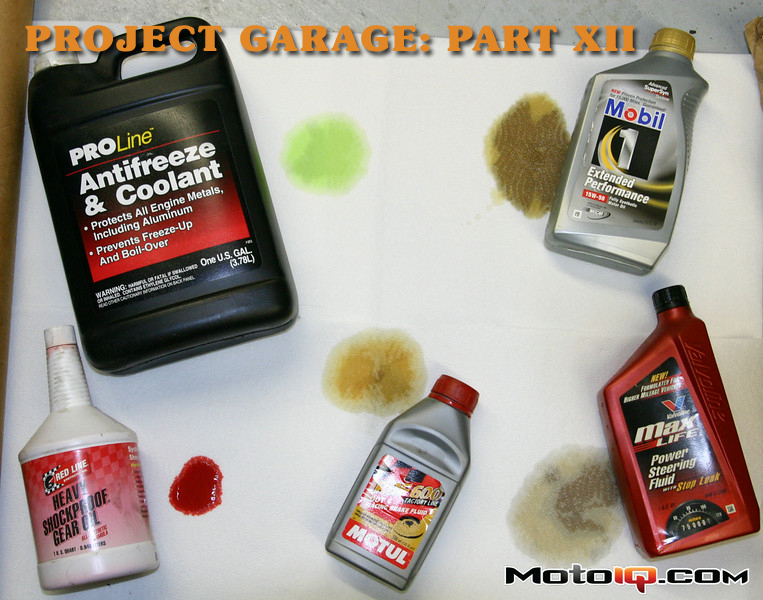,
 Pick your poison.
Pick your poison.If your car did puke some of its contents over the floor, we'll assume you need to fix the problem and refill. Chances are you have bottles of fluids all over so going through the most common ones, here's my list of things to keep on hand:
– Motor Oil: likely an assortment depending on your engines and the weather. I've got everything from 5W-30 for the winter to 15W-50 in the summer, synthetic for almost all of my engines except for the G35 with VQ35DE motor (the 3rd engine within a few years) that loves to consume engine oil like a stoned college student with a bag of potato chips.
– Coolant/Antifreeze: the multi-tasker; must be good at preventing corrosion and from freezing up, transferring heat, have high temperature stability, and be compatible with the elastomers and plastics in the engine.
Here's where being color blind can be a deficiency. Manufacturers add color to antifreeze to identify the source. Traditionally, they are green but there are many colors available now from orange to pink to yellow. Most of the untraditionally colored coolants are longer life “organic” formulas with rust inhibitors meant to last for 100-150k miles rather than the 50k or so found in the traditional coolants. For instance, if your car takes Dexcool (orange, most GM cars), do not mix in Ethylene Glycol (green) or propylene glycol as they are not compatible. When they mix, they form a gelatinous substance that prevents coolant from flowing and can cause your engine to overheat. It also will clog up the engine's passageways, water jackets and radiator so pretty much wreak havoc until something blows like a head gasket. Problems have arisen from these untraditional coolants when the coolant level gets low and oxygen makes its way into the system causing rust to build up. Best bet is not to mix them at all or if necessary, top the organic acid coolant (OAT) off with 10-15% mixture of traditional coolant. Anything more begs to be completely flushed.
And importantly, do not use tap water in your cooling system. It typically contains calcium and magnesium particles that leave deposits which can build up and compromise the cooling system. Use distilled or deionized water instead.
 You know you're a gearhead when you are purchasing fluids by the gallons.
You know you're a gearhead when you are purchasing fluids by the gallons.– Transmission Fluid / Gear oil: Manual transmissions require gear oil changes mostly due to contamination as the metal bearings, gears, and synchronizers wear out. Metal isn't exactly a good lubricant so it's a good idea to flush every 30,000 to 60,000 miles. I usually wait for a clutch spring to pop out or give me some reason to flush the gear oil. My cabinet appears like I raided the Redline booth at SEMA. I like Shockproof 90 for my turbo car and MT90 for most of the other cars.
In automatic transmissions, transmission fluid degrades over time due to the higher temperatures it is subjected to more than having issues due to metal contamination, but it should be flushed every 75,000 miles or so depending on the transmission. I've got one automatic tranny so there's some ATF in my cabinet. Transmission fluid doesn't vanish like engine oil can so if it's low, you likely have a leak.
– Brake fluid: MIQ's legal department would hesitate for me to tell you when brake fluid should be changed. Let's just say as often as it needs to be! If the pedal feels mushy, the lines should be bled. If nothing comes out while bleeding the lines, that's a sign your master cylinder is toast. If the fluid is dark or appears overheated, there could be a stuck caliper and if it appears rusty, moisture is probably contaminating the brake fluid. Brake fluid is hydroscopic (absorbs moisture) which makes it less effective. Air in the lines or a mushy pedal means you may be introducing yourself to the car in front of you so pay attention to that brake fluid!
– Power steering fluid: There's no rule of thumb for changing the power steering fluid. Likely, you'll notice your biceps getting bigger and more effort needed to turn the wheels or in my last case, a puddle on the ground will give away a leaky power steering pump. In general, if you inspect the fluid and its black or contains metal flakes, it's probably overheating and could be indicating the pump is worn. Replacing the pump early on will keep you from having more expensive repairs later like the power steering gear. It could also leak from the reservoir or lines and need to be topped off.
– A/C booster with R134-a refrigerant: keeps your A/C running cool. Fit the charging hose to the low pressure port of the A/C system typically found with a blue or black dust cap. Turn the engine and A/C on high and cool and check the pressure before dispersing to know what to add. R134a is combustible. While it won't ignite under atmospheric pressures and temperatures, when exposed to oxygen, it will burn at high temps or pressures. R134a replaces the R12 refrigerant used a few decades ago before the Earth Day folks knew how destructive it was to the environment.
 What fingerprints?
What fingerprints?– Antisieze lubricant: prevents seizing and corrosion of metal parts from -65 degrees Fahrenheit to 1600F; also helps with disassembly. For use on head bolts, spark plugs, O2 sensor threads, exhaust manifold studs, EGR fittings, and starter and alternator bolts as well as suspension pieces. Copper antisieze works for higher temperature pieces but is high in graphite so shouldn't be used with aluminum. Silver antisieze is better for long term in a harsh environment and is usually nickel based or has low graphite content so is better in conjunction with the softer aluminum.
– Liquid wrench: frees rusted bolts and parts. I've worshipped this stuff a few times while cursing salty winters and their effect on suspension bolts.
– Teflon thread: used on metal or plastic threaded pipes, water, air or gas lines. It cures to a pliable seal to resist pressure and leakage in both low and high pressure applications.
– Threadlocker: Permatex or Loctite, red or blue, more info in this Q&A. Thread locker adhesives bond and seal threaded fasteners, preventing them from shifting or loosening due to vibration and keep them from corroding. Red is heavy strength and provides a permanent seal. Blue is medium strength and will hold but can be disassembled with hand tools for maintenance or repair.
– Engine assembly lube: contains moly-graphite to be used on crankshafts, camshafts, gears, bearings, valve stems, lifters, pushrods, and areas of rotational or sliding contact.



